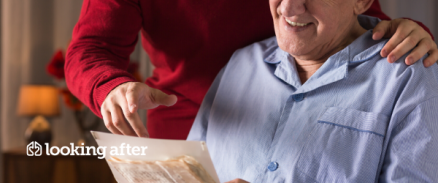Labelling and decluttering
Many dementia patients prefer to have the freedom to live independent lives and making changes around the home, as well as relying on smart technology to support them. It is worth considering placing labels around the house to help make it easier for the dementia patient to find out what things are and know where certain items are or what they are for. Labelling can also be used for simple instructions also.
Labels don’t just have to be words, they can be pictures also, to illustrate what the word means, which helps with memory and vocabulary. This can also help the dementia patient to quickly identify what is in that cupboard. Try putting pictures of crockery and cups, on the cupboard doors.
In the kitchen
Simple labelling in the kitchen can help the dementia patient to navigate their way around. Marking the water taps as hot or cold if they are not already easily identifiable. Quick instructions for switching on the oven (say a switch at the wall) or for operating the kettle or how to use the toaster.
Use pictures on the cupboards to identify some foods that they may use, such as bread or butter. As well as placing labels on different food items to avoid misuse. Clearly marking out sugar and salt, would be one such idea.
When it comes to hazardous materials, such as washing up liquids, surface cleaners or bleaches, use simple labelling for these poisons, consider using a skull and cross bones, or something that they can identify with, that alerts them to danger. However, if you think it warrants being locked away, for the benefit of the dementia patient, then do so.
In the bathroom
Use simple signs to identify where the bathroom or toilet is, if this is separate, or downstairs. Remember to look at the toilet flush. One thing that is important for dementia patients, is that items look like what they are supposed to do. Therefore if the toilet suite is one with a hidden or flat flush, it may require more instructions to identify what it is and what to do. As with other articles, the importance of colour and contrast will certainly help a dementia patient to identify the toilet and seat for example. However, other signs may be required in the bathroom.
Declutter cupboards
Make it easier for the dementia patient to find their items that they are looking for by decluttering drawers and cupboards. Consider putting up shelves in a bathroom which contains all of the things that they may need to use or find. Keep them in plain sight and easy to recognise.
Summary
Signs can be helpful to a dementia patient to identify what it is that they need. Keep labels are eye level or slightly below. Patients suffering with dementia tend to look down, so if you are labelling cupboards, keep them by the handles. The amount of labelling and instructions required will depend on the patient, but making it clear and easy to see will all contribute to enabling the patient to live independently and find items for themselves. When it comes to hazards linked to heat or liquids like bleach, it is unlikely that labelling alone can be relied upon. Think about using other items that can alert the dementia patient to the possible dangers, such as food or drinks being too hot, bath water over running (an overflow will not always be able to cope with a fast running bath), or bath water being too hot. We have an article here that covers in more detail how to keep the home safe. We also consider the various elements to making a kitchen safe here or bathroom safe here.







